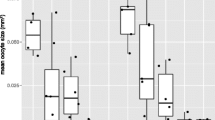Summary.
As Lasius niger societies grow from incipient nests to mature colonies, their foraging strategies shift from the individual exploitation of food sources to mass recruitment. Colony size instead of age is the key factor that shapes the exploratory and foraging responses of Lasius niger: a drastic reduction (or increase) of the population elicits an activity profile similar to that observed in younger (or older) societies of the same size. As a colony grows, the proportion of patrollers significantly decreases while the proportion of conveyors remains rather constant. As regards the energetic return, it increases with incipient nest size due to the replacement of minims by ordinary workers of larger crop capacity. We also demonstrate that minims of incipient nests modulate their trail-laying behaviour according to the social context, in this case the colony size. During their ontogenesis, L. niger colonies exhibit a progressive integration of individual foragers into a network of communication, the adaptive significance of which is discussed.
Similar content being viewed by others
Author information
Authors and Affiliations
Additional information
Received 1 October 2001; revised 31 July 2002; accepted 12 August 2002.
Rights and permissions
About this article
Cite this article
Mailleux, AC., Deneubourg, JL. & Detrain, C. How does colony growth influence communication in ants?. Insectes soc. 50, 24–31 (2003). https://doi.org/10.1007/s000400300004
Issue Date:
DOI: https://doi.org/10.1007/s000400300004




